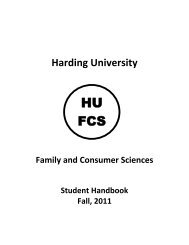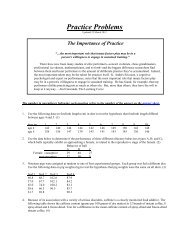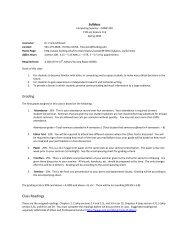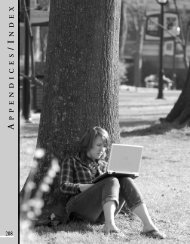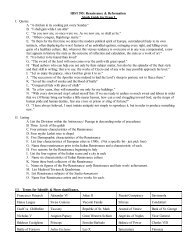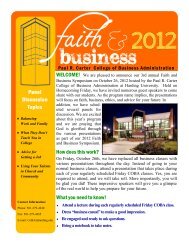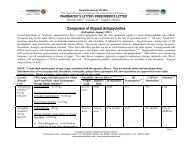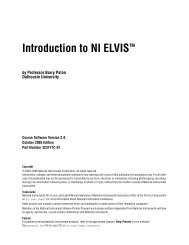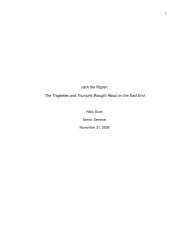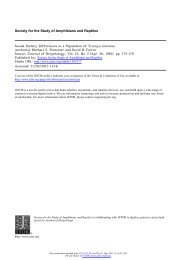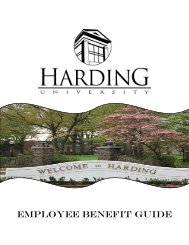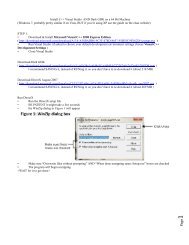Diversity: The Invention of a Concept by Peter Wood - Harding ...
Diversity: The Invention of a Concept by Peter Wood - Harding ...
Diversity: The Invention of a Concept by Peter Wood - Harding ...
Create successful ePaper yourself
Turn your PDF publications into a flip-book with our unique Google optimized e-Paper software.
<strong>Diversity</strong>: <strong>The</strong> <strong>Invention</strong> <strong>of</strong> a <strong>Concept</strong> <strong>by</strong> <strong>Peter</strong> <strong>Wood</strong><br />
Reading Guide – EDFD 645 Dr. Raymond W. “Donny” Lee, Jr.<br />
Page 1<br />
Chapter One -- <strong>Diversity</strong> in America<br />
1. Contrast the meaning <strong>of</strong> the traditional idea <strong>of</strong> diversity as opposed to the<br />
more contemporary “doctrine” <strong>of</strong> diversity (italics, as provided <strong>by</strong> <strong>Wood</strong>) as<br />
suggested <strong>by</strong> <strong>Wood</strong>. What might be implications <strong>of</strong> confusing or juxtaposing<br />
the two?<br />
2. As <strong>Wood</strong> uses these terms, define what he suggests they mean:<br />
a. Diversilogues<br />
b. Diversidacts<br />
c. Diversicrats<br />
d. Diversiphiles<br />
Chapter Two – Imagined <strong>Diversity</strong><br />
1. <strong>Wood</strong> dichotomizes diversity into diversity I and diversity II. Contrast these<br />
conceptually and <strong>by</strong> example.<br />
2. <strong>Wood</strong> states, “Real diversity is <strong>of</strong>ten pr<strong>of</strong>oundly provocative. To encounter<br />
people who are fundamentally unlike yourself is fundamentally unsettling” (p. 29)<br />
Provide a short analysis <strong>of</strong> this assertion using either <strong>Wood</strong>’s points, your own, or<br />
others’.<br />
3. John Sykes (as quoted <strong>by</strong> <strong>Wood</strong>, p. 35) suggests a progression that diversity<br />
advocates follow: tolerated, embraced, and celebrated. What societal or cultural<br />
venues could we see such a progression? Provide an opinion supported <strong>by</strong><br />
examples and illustrations <strong>of</strong> this idea.<br />
4. <strong>Wood</strong> suggests that “artificial diversity’s illusion <strong>of</strong> fairness is really a flickering<br />
<strong>of</strong> several separate fires on the cave walls [alluding to Plato’s Allegory <strong>of</strong> the<br />
Cave which is discussed earlier]. One is the idea that educational access in the<br />
present can make up for denial <strong>of</strong> educational opportunity in the past. . . . [It] is<br />
based on the idea that group affiliation <strong>by</strong> birth is a reasonable stand-in for<br />
worldview or cultural outlook” (pp. 42-43). Discuss these suggested limitations<br />
<strong>of</strong> “artificial diversity” and how they affect cultural and societal institutions today.
<strong>Diversity</strong>: <strong>The</strong> <strong>Invention</strong> <strong>of</strong> a <strong>Concept</strong> <strong>by</strong> <strong>Peter</strong> <strong>Wood</strong><br />
Reading Guide – EDFD 645 Dr. Raymond W. “Donny” Lee, Jr.<br />
Page 2<br />
5. What deleterious effects “artificial diversity” (as described <strong>by</strong> <strong>Wood</strong> on page 42<br />
and following) might have on individuals, groups, and cultural and societal<br />
institutions.<br />
Chapter Three – <strong>Diversity</strong> before <strong>Diversity</strong><br />
1. How does the conception and definition <strong>of</strong> “culture” affect the way we<br />
prescribe and proscribe particular ways <strong>of</strong> acting and reacting to differences<br />
among peoples.<br />
2. How does the traditional, historical reality <strong>of</strong> diversity and the ways various<br />
peoples have dealt with cultural differences affect how diversity as a concept<br />
and more specifically, judgment and toleration as corollaries, have evolved<br />
today? (Can you see a “politically correct” Ripley’s Believe it or Not today as<br />
contrasted with an edition from fifty years ago?)<br />
Chapter Four – <strong>The</strong> Language <strong>of</strong> <strong>Diversity</strong><br />
1. <strong>Wood</strong> asserts, “Race and diversity thus makes an interesting pair,” (p. 87) as he<br />
discusses his view that race is the center <strong>of</strong> diversity. After reading and analyzing<br />
his thoughts on this specific notion, agree or disagree and provide support for<br />
your position.<br />
2. <strong>Wood</strong> provides four meanings for diversity. Briefly describe each and provide a<br />
brief evaluation or critique <strong>of</strong> each.<br />
a. Categorization<br />
b. Representation<br />
c. Ideology<br />
d. Social Scientific Bumbling<br />
3. <strong>Wood</strong> presents some commonly used metaphors for diversity. Using either what<br />
he has provided, or others, choose one that most aptly captures your conception <strong>of</strong><br />
diversity as it is currently reflected <strong>by</strong> diversity advocates today. Be sure to<br />
expound on your metaphor as well as say why it is your choice.
<strong>Diversity</strong>: <strong>The</strong> <strong>Invention</strong> <strong>of</strong> a <strong>Concept</strong> <strong>by</strong> <strong>Peter</strong> <strong>Wood</strong><br />
Reading Guide – EDFD 645 Dr. Raymond W. “Donny” Lee, Jr.<br />
Page 3<br />
4. How could these two phrases be reconciled: “<strong>Diversity</strong> in Unity” and “Unity in<br />
<strong>Diversity</strong>”? Or can they be reconciled? Explain either way.<br />
Chapter Five – Bakke and Beyond<br />
1. June 28, 1978 marks a significant date in the “diversity movement.” Describe<br />
what happened and why it is significant.<br />
2. Powell’s argument in Bakke reflects an emerging idea that the “experience <strong>of</strong><br />
ethnic diversity is a fundamental part <strong>of</strong> a good education” (p. 110). Evaluate<br />
this idea in light <strong>of</strong> Bakke and surrounding arguments as well as any other<br />
sources or experiences. (One consideration: Is there any empirical evidence<br />
that this doctrine is even true?) True or not, what ramifications has this<br />
doctrine had on higher education as well as lower education since the 1970s?<br />
3. <strong>Wood</strong> asks, “Are we really sure we know what racial diversity is?” (p. 120).<br />
Using his explication <strong>of</strong> this question, how would you answer and why? Does<br />
racial diversity produce intellectual diversity (per Bakke and sympathetic<br />
ideologues), and does it matter? Why or why not?<br />
4. Compare and contrast the conception <strong>of</strong> diversity <strong>of</strong> ideas, race, and<br />
experience, and how the three are constructed to interact among the others.<br />
Can assumptions be made about the interrelationships among the three, and if<br />
so, what might they be? What implications arise from this triad <strong>of</strong> diversity for<br />
the culture and society?<br />
5. As <strong>Wood</strong> suggests that no one argues “that social ‘uniformity’ or ethnic<br />
‘homogeneity’ make for a better education or a more just society,” (p. 135)<br />
one is left with the question, what then is the opposite <strong>of</strong> diversity, or perhaps<br />
better stated, what is the counter concept to diversity as it is described in<br />
<strong>Wood</strong>’s text?<br />
6. <strong>Wood</strong> examines Patricia Gurin’s, “Expert Report <strong>of</strong> Patricia Gurin” beginning<br />
on page 137. He says it is a “fascinating attempt to put the ideological claims<br />
<strong>of</strong> diversity on some kind <strong>of</strong> scientific footing.” After reading his analysis, do<br />
you think she has succeeded? Why or why not?<br />
7. What would be the implications <strong>of</strong> whether Gurin has succeeded in providing<br />
a scientific basis for diversity and diversity practices, especially as seen in<br />
higher education, lower education, and hiring and admissions practices?
<strong>Diversity</strong>: <strong>The</strong> <strong>Invention</strong> <strong>of</strong> a <strong>Concept</strong> <strong>by</strong> <strong>Peter</strong> <strong>Wood</strong><br />
Reading Guide – EDFD 645 Dr. Raymond W. “Donny” Lee, Jr.<br />
Page 4<br />
Chapter Six – Diverse Gods<br />
1. According to <strong>Wood</strong>, how has the diversity movement manifested itself within<br />
organized religion in America? What effect has this manifestation produced?<br />
2. Provide a brief analysis <strong>of</strong> the implications <strong>of</strong> religious tolerance, i.e., “tolerance<br />
is not enough and that what is wanted is a kind <strong>of</strong> affirmation or group identity”<br />
(p. 168). How do these same implications reach into higher education and<br />
education in general?<br />
Chapter Seven – <strong>Diversity</strong> Afflicts the Arts<br />
1. How do “artistic spokesmen for their victim groups” (p. 177) further the diversity<br />
movement’s hold on the arts in culture? (Also refer to <strong>Wood</strong>’s discussion <strong>of</strong> the<br />
artist as exemplar and mediator between social worlds on page 191). What are<br />
the ramifications?<br />
2. <strong>Wood</strong> points out that at least two <strong>of</strong> the diversity movement’s goals in the arts are<br />
(1) didactic; and (2) liberation from reliance on stereotypes. What implications<br />
might these have for not only art forms and expressions but for those consuming<br />
the art forms (e.g., children, students, etc.)?<br />
Chapter Seven – Identity Business<br />
1. How has business affected education with respect to its commitment to (ne fear<br />
<strong>of</strong>) the diversity movement, particularly with regard to personnel?<br />
2. What is a “diversity consultant” and how do they operate?<br />
Chapter Nine – <strong>Diversity</strong> on Campus<br />
1. <strong>Wood</strong> asserts, “<strong>Diversity</strong> is probably the most powerful concept on American<br />
college campuses today; it is certainly the most pervasive” (p. 228). Agree or<br />
disagree and provide supporting evidence.<br />
2. <strong>Wood</strong> suggests five implications <strong>of</strong> diversity on college campuses. Briefly<br />
describe each and provide a brief implication.<br />
a. Faculty recruitment
<strong>Diversity</strong>: <strong>The</strong> <strong>Invention</strong> <strong>of</strong> a <strong>Concept</strong> <strong>by</strong> <strong>Peter</strong> <strong>Wood</strong><br />
Reading Guide – EDFD 645 Dr. Raymond W. “Donny” Lee, Jr.<br />
Page 5<br />
b. Acceptance or at least acquiescence <strong>of</strong> existing faculty to racial quota<br />
hiring<br />
c. Establishment <strong>of</strong> new identity-focused courses<br />
d. Reshaping broader curriculum<br />
e. Creating incentives to trim or eliminate academic requirements,<br />
standards, and expectations<br />
3. Contrast the idyllic view <strong>of</strong> diversity as seen <strong>by</strong> its advocates and ideologues with<br />
the real world <strong>of</strong> diversity (according to <strong>Wood</strong>). Would you say his analysis is<br />
correct? Why or why not?<br />
4. On pages 248-249, <strong>Wood</strong> provides a parable <strong>of</strong> sorts about a student applicant at<br />
the Boston University School <strong>of</strong> Law. Read this account and provide an analysis.<br />
5. <strong>Wood</strong> asserts that campus diversity is seldom “inclusive;” rather, it is “accusatory<br />
and divisive” (p. 253). He goes on to say that, “<strong>The</strong> ‘differences’ that come to the<br />
fore are those <strong>of</strong> students who are aggressive in pushing their agendas aimed at<br />
gaining power and privilege, not those <strong>of</strong> the mostly imaginary ideal <strong>of</strong> cultural<br />
exchange.” This is framed is <strong>Wood</strong>’s historical analysis <strong>of</strong> the creation <strong>of</strong> groups<br />
<strong>of</strong> oppressors and the oppressed and the interjection <strong>of</strong> grievances into this<br />
dynamic. Is campus diversity agenda-driven? If so, what evidence and<br />
implications would there be? If not, where has <strong>Wood</strong> missed the boat? How does<br />
his historical analysis contribute to his thesis?<br />
Chapter Twelve – Multitudes<br />
1. Using <strong>Wood</strong>’s three-prongs <strong>of</strong> institutionalized diversity, briefly describe each<br />
prong and its implications:<br />
a. Politics and Economics<br />
b. Culture<br />
c. Demography and Choice<br />
Overall Book<br />
1. What is your overall impression <strong>of</strong> the book? Why?



